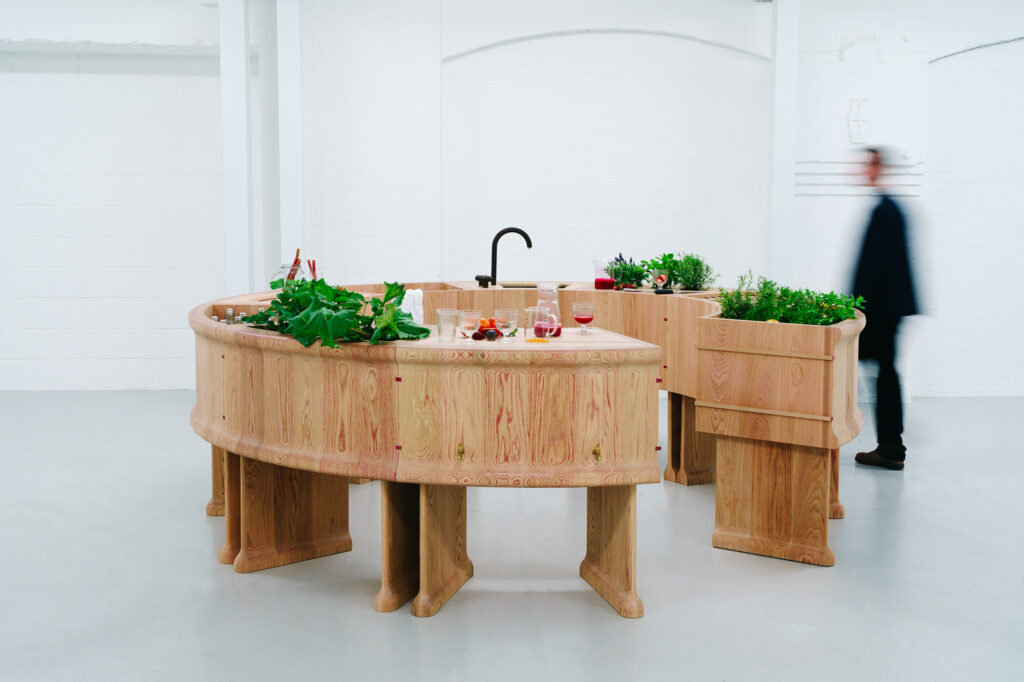Wallpaper* Handmade X: With Love
A vibrant pink circular bar will take pride of place at the Wallpaper* Handmade X: With Love exhibition, designed by architects Chan + Eayrs and made out of red oak by Sebastian Cox. This significant piece has been created to answer the brief of X set by the team at the magazine to celebrate 10 years of its showcase in Milan.
‘Blushing Bar’ is made out of American red oak, in collaboration with the American Hardwood Export Council. It is composed of 10 modules intended for making cocktails (water, alcohol, fruit, herbs, holders, ice, cutting, glass, sodas, wash basin), each of which forms a variation of a curved sculpted element. All 10 modules connect to form a circular bar and will be on show from 9-13 April at Salone dei Tessuti.
“We interpreted X as both ‘10’, for Wallpaper* Handmade’s 10th anniversary, but also a kiss for love, hence the name and colour of the bar. Love makes one blush, and the heart pound; increasing blood circulation through the body through our veins,” says Merlin Eayrs.
“Red oak has a pinkish flesh-like hue, and a porous nature which has capillaries/veins so open you can blow through a short section. These wood veins have been pumped through with deep pink dye by Sebastian Cox, like blood-filled veins through love-struck flesh.”
Zoe Chan adds: “The bar is a place of connection, a focal point for coming together. It feels very personal, much like the projects we tend to take on.”
To dye the wood, Sebastian Cox and his team machined a series of uniform holes into the end grain of red oak, around 25-millimetres deep and 14-millimetres x 30-millimetres wide.
The wood was then put into a purpose-made dying jig. The holes in the end grain were filled with red calligraphy ink. “By filling a series of holes, we can ensure the ink is distributed evenly across the board of red oak. By using calligraphy ink, we get a very intense colour,” says Cox.
A series of clamps are fastened onto the end of the piece of red oak applying an air-tight rubber seal over the end grain and the holes filled with ink.
Once closed, a high-pressured air channel, which is attached to the clamps, is gently opened allowing eight bars of pressured air into the end grain of the wood and the ink-filled holes. This pressured air forces the ink into the uniquely ring porous structure of red oak, emptying the holes in a matter of seconds.
At this point, the ink in the holes is forced through the pores of the wood, also known as xylem, by the pressured air. (Xylem is the name given to the vascular tissue in plants which sends water and dissolved nutrients upwards from the roots of and forms the woody element of the stem or trunk.)
The ink in the xylem of the wood, when viewed in the machined pieces of red oak, effectively highlights what we recognise as the wood’s grain in a bright red colour. These highlights are manipulated through the design and manufacture of the bar to produce the finished effect.
“The properties of wood are traditionally thought of in relation to its strength, hardness and weight but when you start looking at the cellular structure of wood, you can begin to explore other properties. Red oak is uniquely ring porous so this project has been a really fun exploration of its cellular composition and how we can use it to achieve a new aesthetic,” says Cox.
“As a design studio we tend to work with the natural colours of the wood but it’s been wonderfully freeing to use a vivid colour, particularly since we have been using it to highlight the structure of the wood – hopefully encouraging people to think a bit deeper about a really familiar material.”
“What’s more, we believe really strongly that you should use what nature yields and red oak is one of the most abundant species in the American forests and suffers an unfair lack of popularity in Europe. We’ve really enjoyed creating something which will get people to think about less appreciated but incredibly useful materials, like red oak, in a new way.”
David Venables, European Director of AHEC, who has supported various Wallpaper* Handmade projects in the past 10 years, says he was initially nervous about the idea of ‘making red oak more red’, but was won over by the creativity and the beauty of the effect.
“Considering that one of the spurious reasons often given for not using red oak is its colour (a reference to the fact that it is generally warmer in tone than the white oaks from U.S. and Europe), using red ink could be seen as a provocative approach. But that is what our creative programmes do best: they challenge conventional thinking, stir debate, and most importantly, inspire. Achieving such a dramatic and exciting aesthetic effect by using red oak’s unique cellular structure is very clever and demonstrates how a better understanding of the material can inform the design process.”



